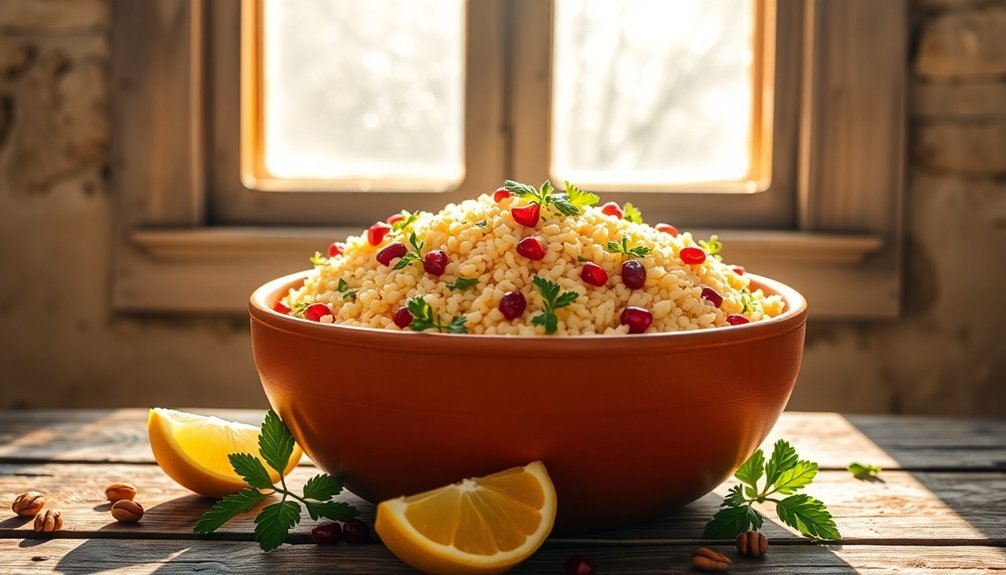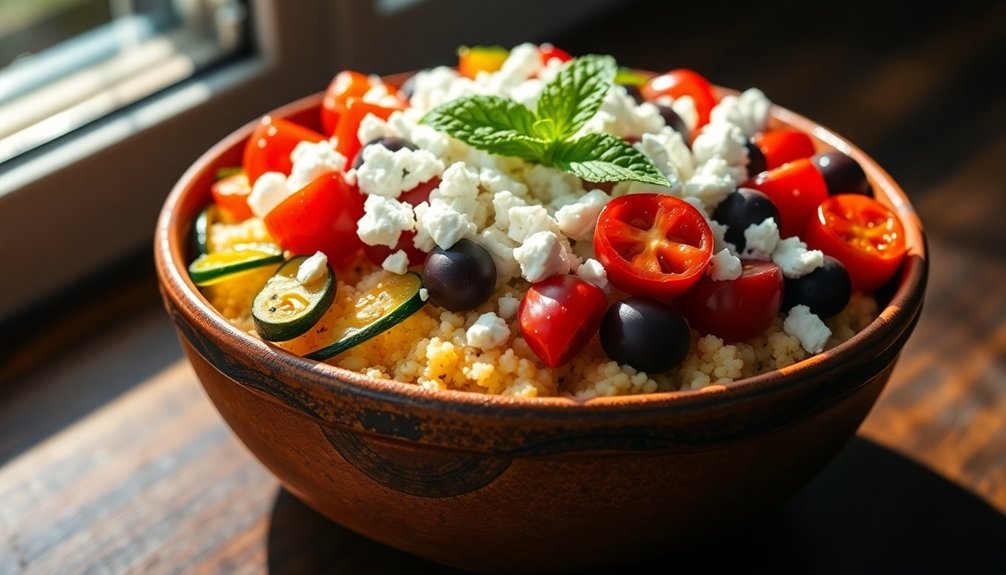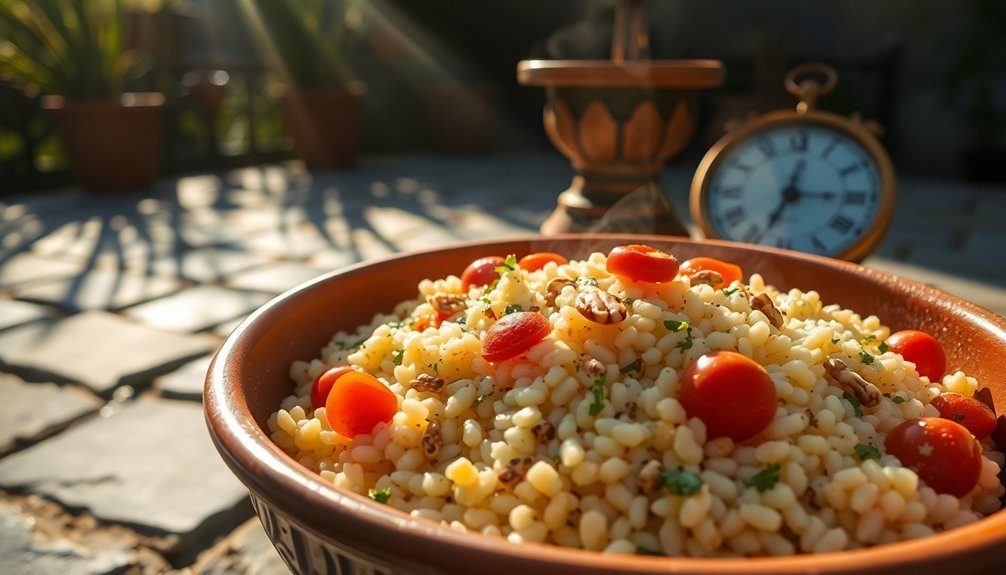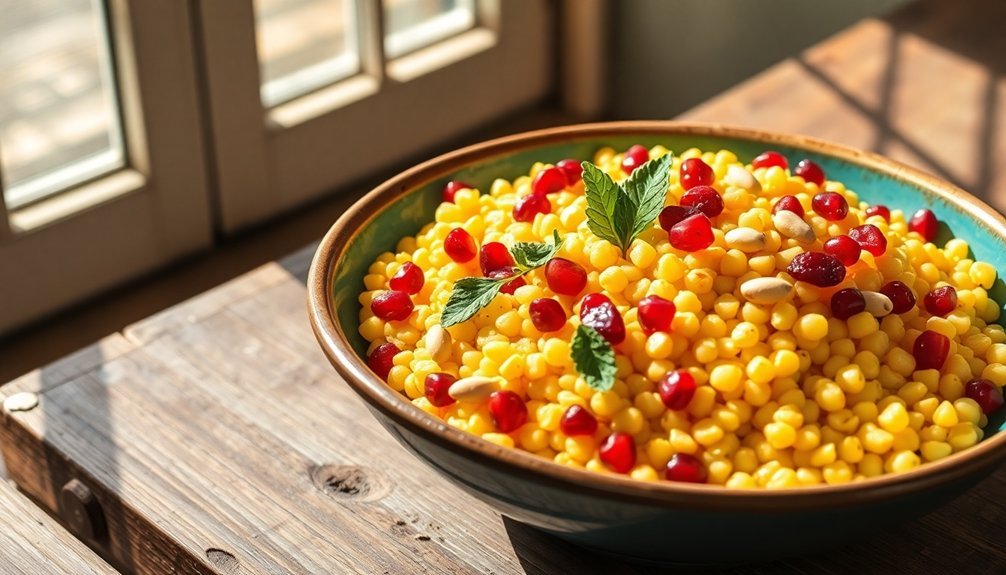Get perfect sun-powered Mediterranean couscous by following these essential tips. Start with a 1:1 ratio of liquid to couscous, and position your solar box at a 15-degree angle for ideal heat absorption. You'll want to maintain temperatures between 150-180°F for proper grain hydration. Layer your ingredients strategically: start with the couscous base, add proteins like chickpeas or feta, then vegetables and fresh herbs. Control steam by properly covering your cooking vessel and monitoring moisture levels. Time each step carefully, from the initial 5-minute liquid heating to the critical 10-minute absorption period. These fundamentals will set you up for countless solar-cooked Mediterranean feasts.
Perfect Couscous Every Time

Getting perfect couscous isn't just about following a recipe – it's about understanding the unique characteristics of each type. Whether you're working with tiny Moroccan grains or larger Israeli pearls, you'll need to adjust your approach accordingly. Moroccan couscous cooks quickly and works beautifully in lighter dishes, while Israeli couscous offers a satisfying chewiness that's perfect for heartier salads. Consider serving your couscous on Friday after prayers, following a cherished North African tradition.
Start by choosing the right liquid ratio – typically 1:1 or 1:1.5 liquid to couscous, depending on your variety. You'll want to bring your cooking liquid to a boil, adding a drizzle of olive oil and a pinch of salt. For extra depth, consider toasting your couscous in a skillet before cooking.
Once you've added the grains to your boiling liquid, cover and remove from heat immediately. Don't disturb the couscous while it's absorbing liquid – this usually takes 5-10 minutes. When it's ready, fluff with a fork to prevent clumping.
For even better results, try briefly soaking your couscous in cold water before cooking, which helps the grains swell and soften uniformly. This extra step can make the difference between good and great couscous.
Solar Box Temperature Control
While perfecting couscous relies on precise timing and measurements, controlling your solar box's temperature demands even more careful attention to detail.
You'll need to maintain ideal cooking temperatures between 65-82°C (150-180°F) for your Mediterranean couscous to properly hydrate and fluff. By implementing both passive and active cooling methods, you can achieve consistent temperature control even on varying sunny days.
To regulate your solar box temperature effectively:
- Mount your solar box with a slight tilt (around 15 degrees) and elevate it 2-3 inches off the surface to enhance natural air circulation and prevent overheating.
- Install a small solar-powered fan system that kicks in when temperatures exceed 82°C, ensuring your couscous doesn't dry out or become tough.
- Position temperature sensors at both the box's center and edges, connecting them to a simple PID controller that'll adjust ventilation automatically.
- Set up a differential thermostat to monitor the temperature difference between your box's cooking chamber and the ambient air.
You can fine-tune your PID controller's parameters (Kp, Ki, Kd) based on your local climate conditions, ensuring consistent results regardless of weather variations. Regular monitoring of your solar box is crucial, as a 10°C temperature rise can significantly impact its cooking performance.
Layer Your Mediterranean Ingredients

The art of layering Mediterranean ingredients transforms ordinary couscous into a vibrant, flavor-packed dish.
Start by selecting your base – pearl, Israeli, or Moroccan-style couscous. You'll want to cook it in hot water using a 1:1 ratio, letting it rest for 5 minutes after absorption. For enhanced flavor, try toasting your pearl couscous in olive oil before cooking. Begin with a foundational layer of warm olive oil.
Next, incorporate your proteins and grains. Add chickpeas for a protein boost, or swap in white beans if you prefer. Crumble feta cheese for tanginess, and sprinkle pine nuts for crunch. For extra heartiness, include Italian chicken sausage.
Layer in your vegetables strategically. Mix cherry tomatoes with sun-dried varieties for a depth of tomato flavor. Add diced cucumbers and bell peppers for freshness and crunch. Don't forget to incorporate spinach – fresh or frozen – for additional nutrients.
Finally, enhance your dish with Mediterranean seasonings. Sprinkle fresh herbs like parsley, mint, or basil throughout. Add depth with sumac, oregano, and cumin. Finish with a squeeze of fresh lemon juice and a touch of garlic. For heat lovers, add red pepper flakes to taste.
Prevent Steam From Escaping
Steam control plays an important role in achieving perfectly cooked Mediterranean couscous. To maintain ideal steam flow, you'll need to set up your steamer basket properly, making sure it doesn't touch the water below while wrapping a towel or cheesecloth around the insert to direct steam upward through the couscous.
You'll want to keep your pot at a steady simmer, filling it halfway with water or broth to generate consistent steam. Don't cover the couscous during cooking, as this prevents proper steam circulation and affects the final texture. Instead, monitor the steam flow to guarantee it's rising evenly through the grains.
For the best results, follow these vital steps:
- Position the steamer basket securely above the boiling water.
- Wrap the steamer insert with a towel to prevent steam from escaping sideways.
- Maintain medium-high heat to keep steam flowing consistently.
- Check for steam rising through the couscous after about 10 minutes.
Once steaming is complete, let the couscous cool slightly before handling. Add cold water and olive oil to separate the grains while minimizing steam loss, then gently rub between your hands to prevent clumping.
Timing Your Solar Recipe

Proper timing transforms a good Mediterranean couscous dish into an exceptional one. To achieve perfect results, you'll need to coordinate several steps efficiently.
Start by bringing your broth or water to a boil, which takes about 5 minutes. While you're waiting, use this time to prep your ingredients – chop olives, dice sun-dried tomatoes, and cube your feta cheese, a process that typically takes 3-5 minutes.
If you're choosing to toast your couscous, spend 1-3 minutes browning it in olive oil before adding it to your boiling liquid. Once you've added the couscous, immediately remove it from heat and let it sit covered for 5-10 minutes to absorb the liquid properly.
During this absorption time, you can toast pine nuts in a dry skillet for 1-3 minutes and sauté garlic with red pepper flakes and sun-dried tomatoes.
After fluffing your couscous, you're ready to combine it with your prepared ingredients. You can serve it immediately while hot, or chill it for a revitalizing cold salad.
For meal prep purposes, portion the finished dish into containers and customize with additional proteins or roasted vegetables of your choice.
Frequently Asked Questions
Can I Substitute Quinoa or Rice for Couscous in Solar Cooking?
Yes, you can substitute quinoa or rice for couscous in solar cooking. You'll need to adjust cooking times and liquid ratios, as quinoa takes about 12 minutes and rice takes 10 minutes when traditionally boiled.
How Do Weather Conditions Affect the Seasoning and Spice Measurements?
You'll need to adjust spice amounts based on humidity and sunlight. High humidity reduces spice potency, so add more. Strong sunlight degrades spices faster, so consider adding some seasonings near the end of cooking.
Which Vegetables Should I Avoid When Making Solar-Cooked Mediterranean Couscous?
You'll want to avoid cruciferous vegetables, okra, squash, and vegetables with high moisture content. Also skip root vegetables and those needing high heat, as they won't cook properly in a solar oven.
Will Solar Cooking Change the Taste of Feta Cheese?
You won't notice significant taste changes in feta cheese when solar cooking, as the gentle, even heat preserves its natural flavors. Just add it near the end of cooking to maintain its distinctive taste and texture.
Can I Prepare the Ingredients the Night Before Solar Cooking?
Yes, you can prep your ingredients the night before! Chop veggies, cube feta, and store everything in airtight containers in the fridge. Just wait to cook the couscous until you're ready to solar cook.
In Summary
You'll find solar-cooked Mediterranean couscous isn't just eco-friendly – it's deliciously simple once you've mastered these fundamentals. Keep your solar box at 180-200°F, layer those vibrant Mediterranean ingredients thoughtfully, and don't let precious steam escape. With proper timing and temperature control, you're all set for fluffy, flavorful couscous that harnesses the sun's natural energy. Give it a try on your next sunny day!





Leave a Reply